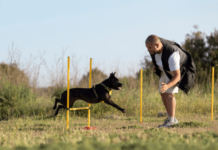Last Updated on October 21, 2024 by Dogs Vets
In recent years, protection dogs have gained significant popularity among residents of Britain. These dogs are trained to provide both safety and companionship, offering an unparalleled level of security and loyalty. With the help of professional insights, we’ll explore why protection dogs are becoming a favored choice for many and how to ensure they are both effective and loving companions.
Understanding Protection Dogs
Protection dogs are not just ordinary pets; they are specifically trained to guard and protect their owners and property. Unlike regular pets, these dogs undergo rigorous training to hone their natural instincts, as rea here https://www.totalk9.co.uk/totalk9-personal-protection-dogs.php , and learn commands that ensure they act appropriately in various situations. The primary objective of a protection dog is to provide security, but they also offer emotional support and companionship to their owners.
Protection dogs can be categorized into several types, including personal protection dogs, family protection dogs, and estate protection dogs. Each type serves a specific purpose:
Personal Protection Dogs: These dogs are trained to protect an individual and are often by their side, ready to respond to any threat.
Family Protection Dogs These dogs are trained to safeguard an entire family, including children, making them suitable for households.
Estate Protection Dogs These dogs are ideal for guarding larger properties and estates, providing security over a wide area.
Training of Protection Dogs
The training of protection dogs is a meticulous process that requires expertise and patience. The process usually starts when the dog is a puppy, although older dogs can also be trained effectively. The training encompasses various aspects, including obedience, socialization, and protection work.
Obedience Training
Obedience training is the foundation of any protection dog’s education. It involves teaching the dog basic commands such as sit, stay, come, and heel. This ensures the dog can follow instructions and remain under control in different situations.
Socialization
Socialization is crucial for protection dogs to ensure they can differentiate between normal and threatening situations. Dogs are exposed to various environments, people, and animals to build their confidence and ability to respond appropriately.
Protection Work
Protection work involves teaching the dog to guard and defend. This includes bite work, where the dog learns to apprehend a threat on command and release when instructed. The dog is trained to respond to specific cues and only act when necessary, ensuring they do not become a danger to the public.
Expert trainers use positive reinforcement techniques to train protection dogs, rewarding them for correct behavior to build trust and confidence. Consistency and repetition are key to ensuring the dog retains and applies what they have learned.
Benefits of Protection Dogs
The benefits of owning a protection dog extend beyond security. These dogs offer a range of advantages that enhance the quality of life for their owners.
Enhanced Security
The primary benefit of a protection dog is the enhanced security they provide. Their presence alone can deter potential intruders or attackers, and their training ensures they can handle real threats effectively.
Loyal Companionship
Protection dogs are loyal companions who form strong bonds with their owners. They offer emotional support, companionship, and can help alleviate feelings of loneliness or anxiety.
Physical Fitness
Owning a protection dog encourages physical activity. Regular walks, playtime, and training sessions keep both the dog and owner active and fit.
Peace of Mind
Knowing that a well-trained protection dog is guarding your home and family provides immense peace of mind. Owners can feel safer and more secure in their daily lives.
Enhanced Property Value
For those with larger estates, a protection dog can enhance property value by providing a level of security that electronic systems cannot match.
Selecting the Right Protection Dog
Choosing the right protection dog is crucial to ensure it fits well with your lifestyle and needs. Various factors should be considered when selecting a protection dog:
Breed
Certain breeds are more suited to protection work due to their temperament, size, and intelligence. Common breeds used for protection include German Shepherds, Belgian Malinois, Rottweilers, and Doberman Pinschers. Each breed has its unique characteristics, so it’s essential to choose one that matches your requirements.
Temperament
The dog’s temperament is a critical factor. A good protection dog should be confident, calm, and not easily startled. They should be able to distinguish between normal and threatening situations and react appropriately.
Age
While puppies can be trained from a young age, older dogs can also make excellent protection dogs if they have the right temperament and are in good health. Training an older dog might take longer, but it can be just as effective.
Health
The health of the dog is paramount. Ensure the dog has undergone health screenings and is free from genetic disorders that could affect its performance and longevity.
Training
The level of training the dog has received is essential. It is advisable to acquire a protection dog from reputable trainers who can provide documentation of the training and certification.
Integrating a Protection Dog into Your Home
Bringing a protection dog into your home requires careful planning and consideration to ensure a smooth transition and integration. Here are some steps to help you integrate a protection dog into your household:
Prepare Your Home
Before bringing the dog home, ensure your living space is prepared. Create a designated area for the dog with a comfortable bed, toys, and feeding bowls. Secure your property to prevent the dog from escaping and ensure there are no hazards.
Introduce Gradually
Introduce the protection dog to family members and other pets gradually. Allow the dog to explore its new environment and get accustomed to the new smells and sounds. Supervise interactions to ensure everyone feels safe and comfortable.
Establish Routine
Dogs thrive on routine. Establish a consistent schedule for feeding, walking, and training. This helps the dog settle into its new home and understand what is expected of it.
Continued Training
Continued training is essential to reinforce what the dog has learned. Work with a professional trainer to ensure the dog’s skills remain sharp and it stays obedient.
Socialization
Continue socializing the dog to different environments and situations. This helps maintain its confidence and ability to handle various scenarios.
Regular Exercise
Protection dogs require regular exercise to keep them healthy and happy. Engage in activities that challenge them both physically and mentally.
Legal Considerations and Responsibilities
Owning a protection dog in Britain comes with legal responsibilities and considerations. It is essential to be aware of these to ensure compliance with the law and the safety of the public.
Dangerous Dogs Act 1991
The Dangerous Dogs Act 1991 outlines the breeds that are prohibited in Britain and the responsibilities of dog owners. Ensure your protection dog does not fall under the banned breeds and that it is well-trained and controlled.
Public Liability Insurance
It is advisable to have public liability insurance for your protection dog. This covers any potential damages or injuries the dog may cause to third parties.
Control in Public
Protection dogs must be under control in public places. Use a leash and, if necessary, a muzzle to prevent any incidents. Ensure the dog responds to commands and behaves appropriately around strangers.
Identification
Ensure your protection dog is microchipped and wears an identification tag with your contact information. This is crucial in case the dog gets lost or involved in an incident.
Health and Welfare
As an owner, you are responsible for the health and welfare of your protection dog. Provide regular veterinary care, a balanced diet, and a safe environment to ensure the dog’s well-being.
Protection Dogs and Families
Protection dogs can be excellent additions to families, providing both security and companionship. When integrating a protection dog into a family with children, specific considerations must be taken into account:
Child Safety
Ensure the protection dog is well-socialized with children. Teach children how to interact with the dog safely and respectfully. Supervise interactions, especially with younger children, to prevent any accidents.
Training and Boundaries
Establish clear boundaries and rules for both the dog and children. This includes teaching the dog not to jump on or roughhouse with children and instructing children not to disturb the dog while it is eating or resting.
Positive Reinforcement
Use positive reinforcement to encourage good behavior from the dog around children. Reward the dog for calm and gentle interactions with treats or praise.
Family Involvement
Involve the entire family in the dog’s training and care. This helps build a strong bond between the dog and all family members and ensures everyone understands how to handle the dog correctly.
Protection Dogs and the Elderly
Protection dogs can also provide immense benefits to elderly individuals, offering both security and companionship. However, certain considerations should be taken into account:
Suitable Breed and Size
Choose a breed and size that are manageable for the elderly individual. Some breeds may be too large or energetic for an older person to handle comfortably.
Training and Assistance
Consider training the protection dog to assist with daily tasks. This can include fetching items, opening doors, or providing support when walking.
Exercise Needs
Ensure the dog’s exercise needs can be met. For elderly individuals who may not be able to walk the dog regularly, consider hiring a dog walker or enlisting help from family members.
Health and Safety
Ensure the dog’s presence does not pose a risk to the elderly individual. This includes training the dog to move gently and not to obstruct pathways.
Conclusion
Protection dogs offer a unique blend of security and companionship, making them a valuable addition to many households in Britain. Their rigorous training ensures they can effectively protect their owners while also providing loyal companionship. When selecting and integrating a protection dog into your home, careful consideration and preparation are essential to ensure a successful and harmonious relationship.
With the right approach, protection dogs can enhance the quality of life, providing peace of mind, safety, and unwavering loyalty. By understanding the training, benefits, and responsibilities associated with protection dogs, you can make an informed decision and enjoy the many advantages these remarkable animals offer.

















